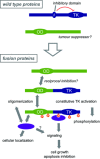Tyrosine kinase gene fusions in cancer: translating mechanisms into targeted therapies
- PMID: 21854543
- PMCID: PMC3823288
- DOI: 10.1111/j.1582-4934.2011.01415.x
Tyrosine kinase gene fusions in cancer: translating mechanisms into targeted therapies
Abstract
Tyrosine kinase fusion genes represent an important class of oncogenes associated with leukaemia and solid tumours. They are produced by translocations and other chromosomal rearrangements of a subset of tyrosine kinase genes, including ABL, PDGFRA, PDGFRB, FGFR1, SYK, RET, JAK2 and ALK. Based on recent findings, this review discusses the common mechanisms of activation of these fusion genes. Enforced oligomerization and inactivation of inhibitory domains are the two key processes that switch on the kinase domain. Activated tyrosine kinase fusions then signal via an array of transduction cascades, which are largely shared. In addition, the fusion partner provides a scaffold for the recruitment of proteins that contribute to signalling, protein stability, cellular localization and oligomerization. The expression level of the fusion protein is another critical parameter. Its transcription is controlled by the partner gene promoter, while translation may be regulated by miRNA. Several mechanisms also prevent the degradation of the oncoprotein by proteasomes and lysosomes, leading to its accumulation in cells. The selective inhibition of the tyrosine kinase activity by adenosine-5'-triphosphate competitors, such as imatinib, is a major therapeutic success. Imatinib induces remission in leukaemia patients that are positive for BCR-ABL or PDGFR fusions. Recently, crizotinib produced promising results in a subtype of lung cancers with ALK fusion. However, resistance was reported in both cases, partially due to mutations. To tackle this problem, additional levels of therapeutic interventions are suggested by the complex mechanisms of fusion tyrosine kinase activation. New approaches include allosteric inhibition and interfering with oligomerization or chaperones.
© 2011 The Authors Journal of Cellular and Molecular Medicine © 2011 Foundation for Cellular and Molecular Medicine/Blackwell Publishing Ltd.
Figures




References
-
- Ren R. Mechanisms of BCR-ABL in the pathogenesis of chronic myelogenous leukaemia. Nat Rev Cancer. 2005;5:172–83. - PubMed
-
- Toffalini F, Demoulin JB. New insights into the mechanisms of hematopoietic cell transformation by activated receptor tyrosine kinases. Blood. 2010;116:2429–37. - PubMed
-
- Lacronique V, Boureux A, Valle VD, et al. A TEL-JAK2 fusion protein with constitutive kinase activity in human leukemia. Science. 1997;278:1309–12. - PubMed
-
- Santoro M, Melillo RM, Fusco A. RET/PTC activation in papillary thyroid carcinoma: European Journal of Endocrinology Prize Lecture. Eur J Endocrinol. 2006;155:645–53. - PubMed
Publication types
MeSH terms
Substances
LinkOut - more resources
Full Text Sources
Other Literature Sources
Miscellaneous

